Calendly vs Cal.com: Which is the best scheduling platform?
Table of Contents
Get Booked in Seconds!
Sign up to OneCal today to effortlessly create and share your scheduling links in seconds.
Since its launch in 2013, Calendly has inspired the launch of many scheduling tools, striving to one day become as big, or bigger than Calendly. One of the scheduling platforms that took inspiration from Calendly is Cal.com. Cal.com was founded with the goal of providing an alternative to existing scheduling tools with a focus on privacy and transparency.
In 2021, Cal.com raised $7.4m Seed, granting them facilities and resources to develop the scheduling infrastructure that would challenge Calendly. The question that needs to be asked is, how does Cal.com compare with Calendly?
In this article, we’ll compare Calendly with Cal.com, and explain the similarities, differences, pricing, ease of use, security, and more. Let’s get started.
Calendly vs Cal.com, what do they offer?
Let’s get started by explaining the core philosophy of Cal.com and Calendly:
Calendly
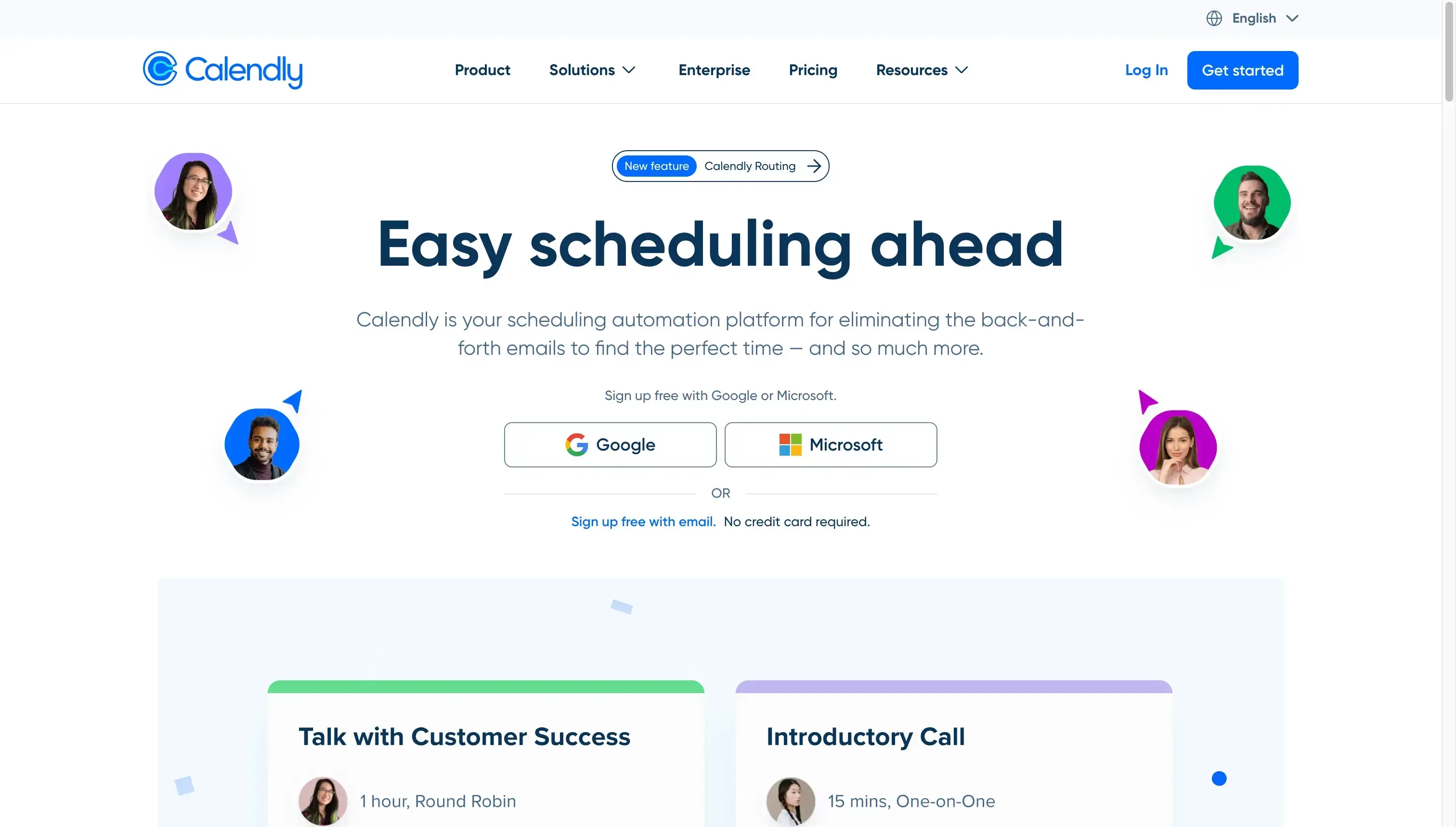
Calendly is a cloud-based appointment scheduling software that simplifies the process of setting up meetings and appointments. It allows individuals and businesses to create availability preferences, share their calendars via a link, and invite others to schedule a meeting during available times, eliminating the back-and-forth typically associated with booking appointments.
Features:
Customizable Scheduling Links: Calendly is most known because of its intuitive scheduling links, which are highly customizable. You can set up different types of meetings, such as follow-ups, team meetings, 1:1 meetings, and more. Each meeting can have a custom length, availability, and rules.
Integration with Calendar Apps: Calendly integrates with Google Calendar, Outlook, Office 365, iCloud, and other apps like Zoom, Teams, Slack, and payment processors such as Stripe and PayPal.
Team scheduling links: With Calendly you can schedule multi-person meetings, not having to worry about the availability of each person.
Routing: Calendly has added a new feature called Routing, which allows you to screen leads from your CRM, and route them to account owners to Salesforce.
Interested in comparing Calendly with its best competitors? Read our article on the 7 Best Calendly Alternatives [Free and Paid]
Cal.com
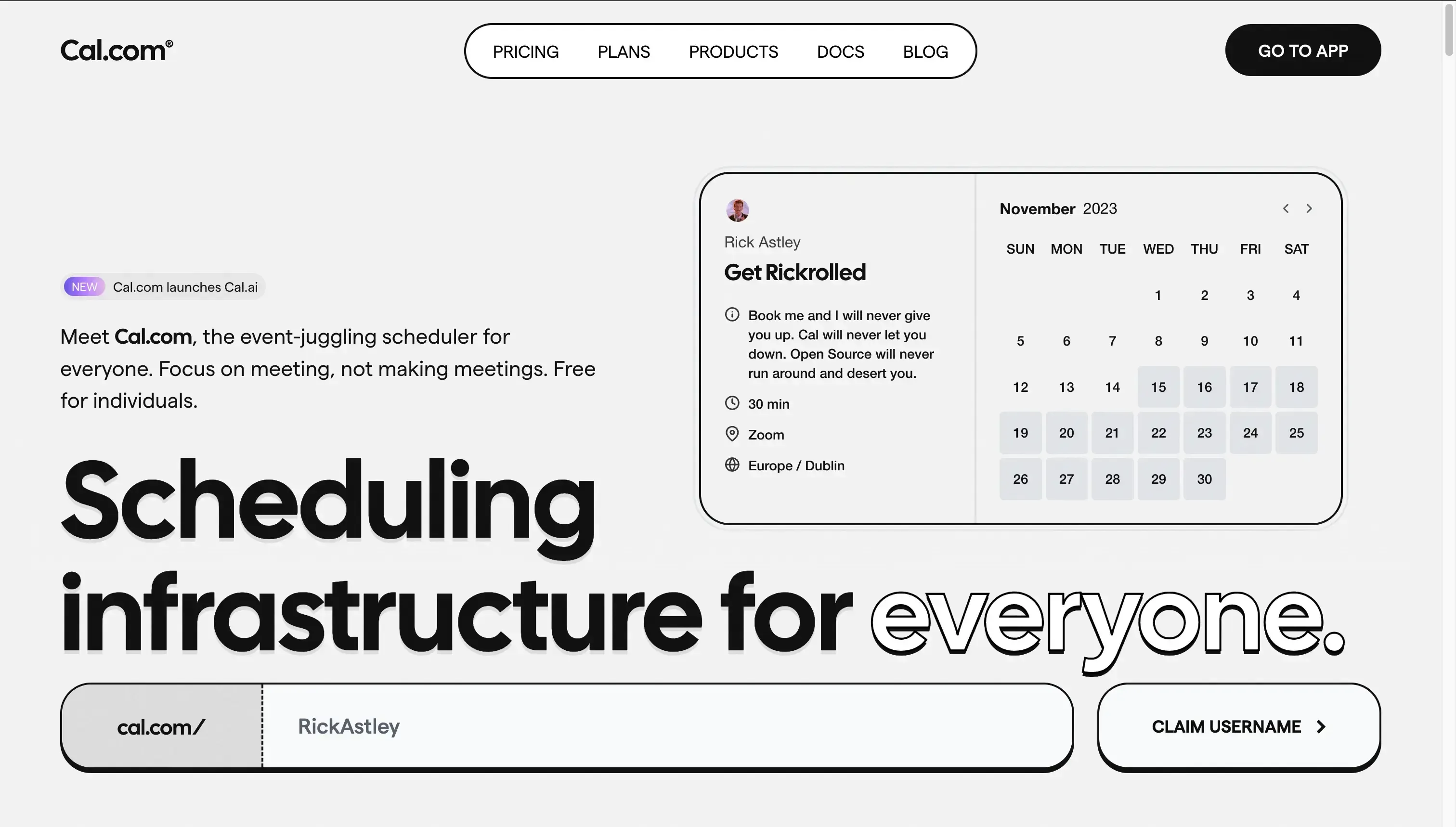
Cal.com (formerly known as Calendso), is the most popular open-source scheduling platform, supported by thousands of developers who aim to make scheduling more transparent and accessible to everyone.
Features:
Open-Source codebase: One of the platform's main attractions is that it is open-source, which means that users can self-host their instance of the software. Furthermore, the contributions are open to everyone, if you’re a developer and use Cal.com, you can contribute and feel a part of the team.
Flexible Integrations: Despite being younger than Calendly, Cal.com offers many integrations with popular services such as Google Calendar, Office 365, Outlook, and more. Cal.com also has an interesting concept called Apps, which we’ll discuss later in the article.
Configurable: Cal.com is as versatile as Calendly, allowing users to manage their time efficiently. You can create different types of events, and define custom durations and availabilities.
Looking to know more about Cal.com and its competitors? Read our article on Top 7 Cal.com Alternatives - [How They Compare + Similarities]
Who is Cal.com for?
Given the open-source nature of Cal.com, it appeals more to enthusiasts who value transparency and open-source contribution. This is not to say that large enterprises can’t use Cal.com, as Cal.com has enterprise plans and is strongly pushing toward team usage. Cal.com is designed to be a versatile scheduling platform, that can be used by:
Individuals: Freelancers, consultants, and professionals who need to schedule meetings with clients or collaborators can use Cal.com to streamline their booking process.
Small to Medium Businesses (SMBs): SMBs can use Cal.com to manage appointments across different teams and services.
Large Enterprises: With its customizable and self-hostable approach, large organizations can integrate Cal.com into their existing workflows, ensuring that their scheduling system aligns with company policies, especially concerning security and data privacy.
Who is Calendly for?
Calendly has been in the scheduling niche for a long time, and it’s the go-to tool for individuals and businesses of any size.
Professionals and Entrepreneurs: Individuals such as consultants, coaches, sales professionals, and freelancers use Calendly to manage appointments without the back-and-forth of emails.
Business Teams and Enterprises: From small business teams to departments within large corporations, Calendly helps coordinate meetings, interviews, and collaborative sessions.
Calendly vs Cal.com: A Detailed Feature Comparison
Let’s compare Calendly vs Cal.com taking into account the pricing, specific features, ease of use, integrations, security, and more, to determine which is the winner.
Scheduling
Given that the primary purpose of Cal.com and Calendly is simplifying the scheduling process, offering various features to manage appointments and meetings efficiently is crucial. The good news is that both Calendly and Cal.com are quite comparable regarding scheduling features, as both offer 1:1 scheduling, use multi-use event types, team scheduling, can handle payments, and more.
Calendly's Scheduling Features:
One-on-One Meetings: Calendly allows you to set available times, and invitees can book these slots on a first-come, first-served basis.
Group Meetings: You can schedule meetings with multiple people, where all invited parties can attend at the same time.
Round Robin: Distributes meetings between team members based on availability or priority.
Collective Scheduling: Calendly can coordinate with the calendars of multiple team members to find times when everyone is available.
Time Zone Intelligent: Automatically detects the invitee’s time zone to help prevent confusion.
Buffer Times: Allows you to set buffer times between meetings.
Minimum Scheduling Notice: Prevents last-minute bookings by setting how much notice you need before a meeting.
Customizable Notifications and Reminders: Send automated email and SMS reminders to reduce no-shows.
Payment Integration: Integrate with payment processors like PayPal and Stripe for paid appointments.
Availability Preferences: Customize your availability to show as much or as little free time as you wish.
Calendly scheduling link:
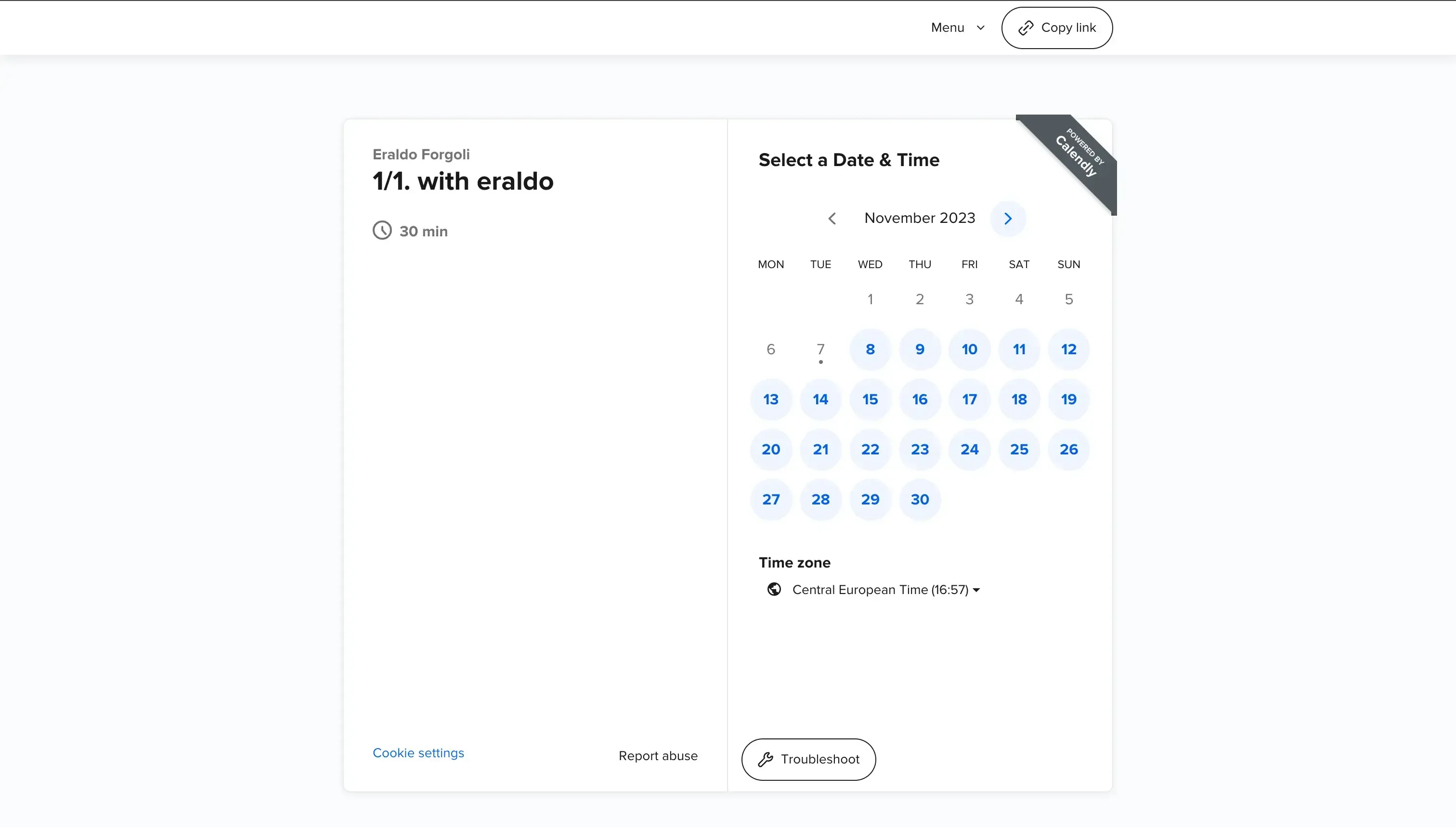
Cal.com's Scheduling Features:
One-on-One Meetings: Allows individuals to book a time with you based on your availability, similar to what you’d expect from any scheduling tool.
Group Meetings: Enables scheduling of events that multiple people can attend simultaneously. This is great for webinars, classes, or group workshops.
Round Robin Meetings: Distributes meetings among team members. This is typically used for sales or support teams where leads or tickets are assigned to the next available representative.
Collective Availability: Finds common available times for team members, which is useful for internal meetings or client meetings involving multiple stakeholders from your team.
Time Zone Management: Cal.com automatically handles time zone conversions, ensuring that meeting times are accurate for all participants regardless of their location.
Buffer Times: You can set buffer times before or after events to ensure you don’t have back-to-back bookings without breaks.
Minimum Scheduling Notice: Prevents surprises by allowing you to specify how much advance notice you need before someone can book a meeting.
Customizable Notifications and Reminders: Automated email notifications and reminders can be set up to keep participants informed and prompt.
Integrated Payment Processing: Offers the ability to charge for appointments directly through the platform by integrating with payment processors.
Availability Preferences: You can set specific times when you are available for meetings, providing flexibility and control over your schedule.
Custom Fields: When setting up events, you can request additional information from the invitee by adding custom questions or fields.
These features of Cal.com provide a solid scheduling platform capable of handling various types of bookings, from individual appointments to large group events. The platform is designed to offer both flexibility and ease of use for individuals and teams to organize their schedules efficiently.
Cal.com scheduling links:
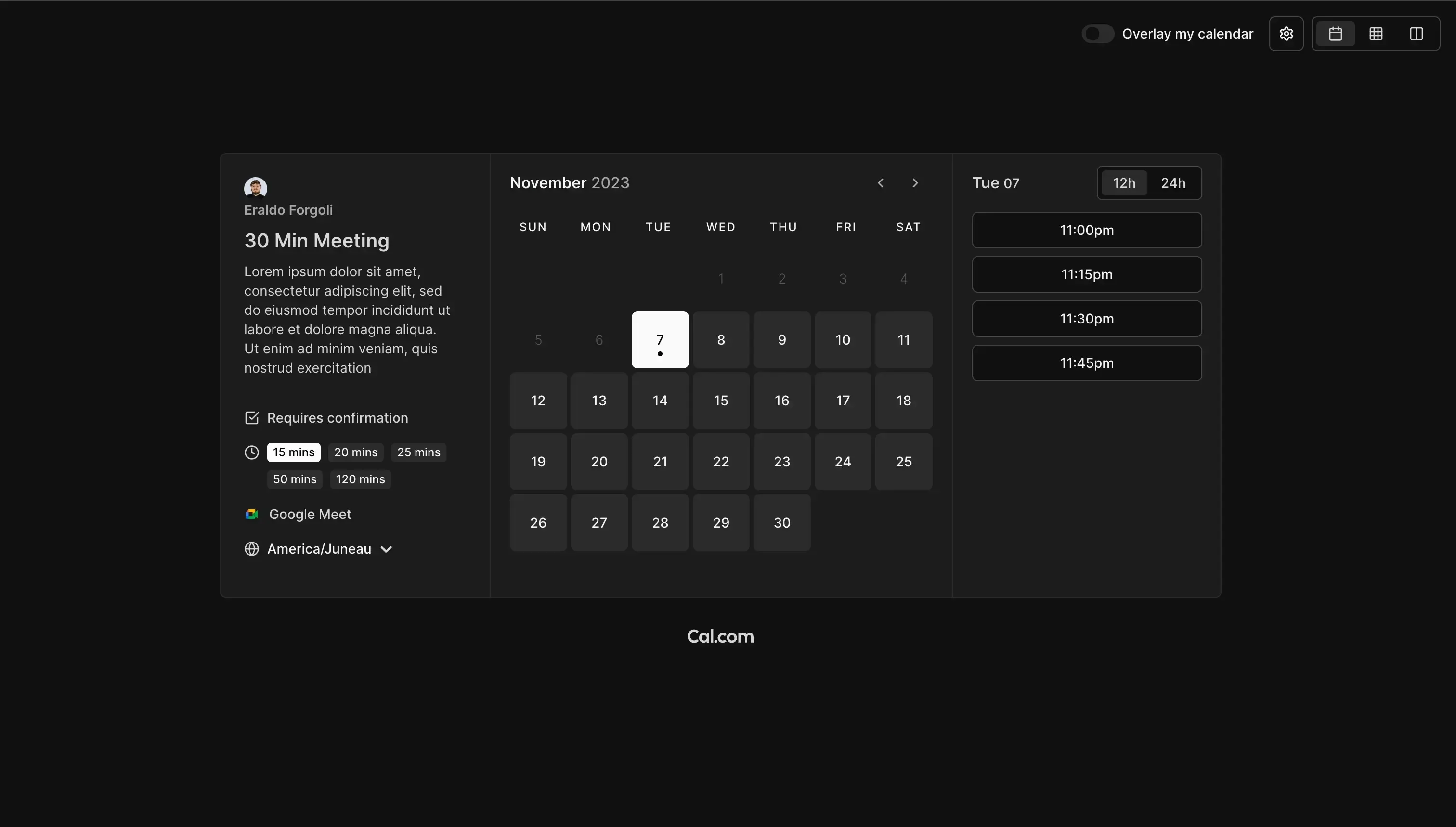
Cal.com week view:
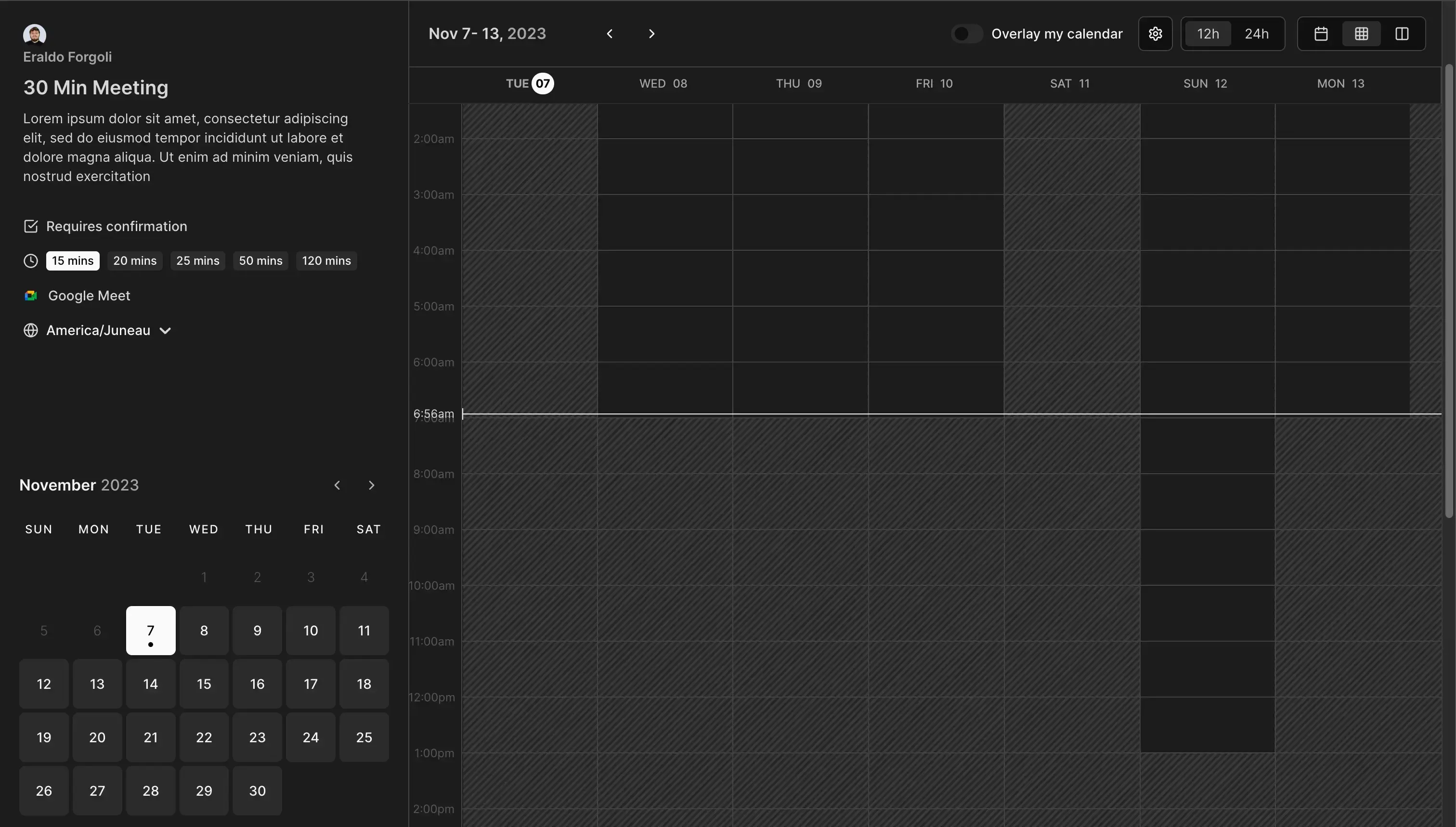
Conclusion: Both Cal.com and Calendly are packed with scheduling features, so it’s a tie.
UI, UX, ease of use
When comparing the UI of Cal.com with Calendly, it’s noticeable that Cal.com has a more modern UI, with the ability to change to light or dark mode. This is expected, as Cal.com has just started out, and has had the chance to experiment and create something special. Calendly on the other hand, already has a brand identity and design language, and it’s pretty hard to drastically change the UI.
That said, Calendly has recently refreshed the UI, making it easier to navigate and schedule meetings.
UX-wise, Cal.com is still superior to Calendly, as the product is well thought out. It’s extremely easy to navigate between the menus, create booking links, manage meetings, and more. This is not to say that Calendly’s UX is not fleshed out, it’s just that Cal.com has a better UX.
Furthermore, Cal.com has added the Calendar Overlay feature, which allows users to overlay their calendar on top of the calendar of the users they’re trying to meet with, providing a very intuitive scheduling experience, which leads to fewer double-bookings.
Cal.com UI:
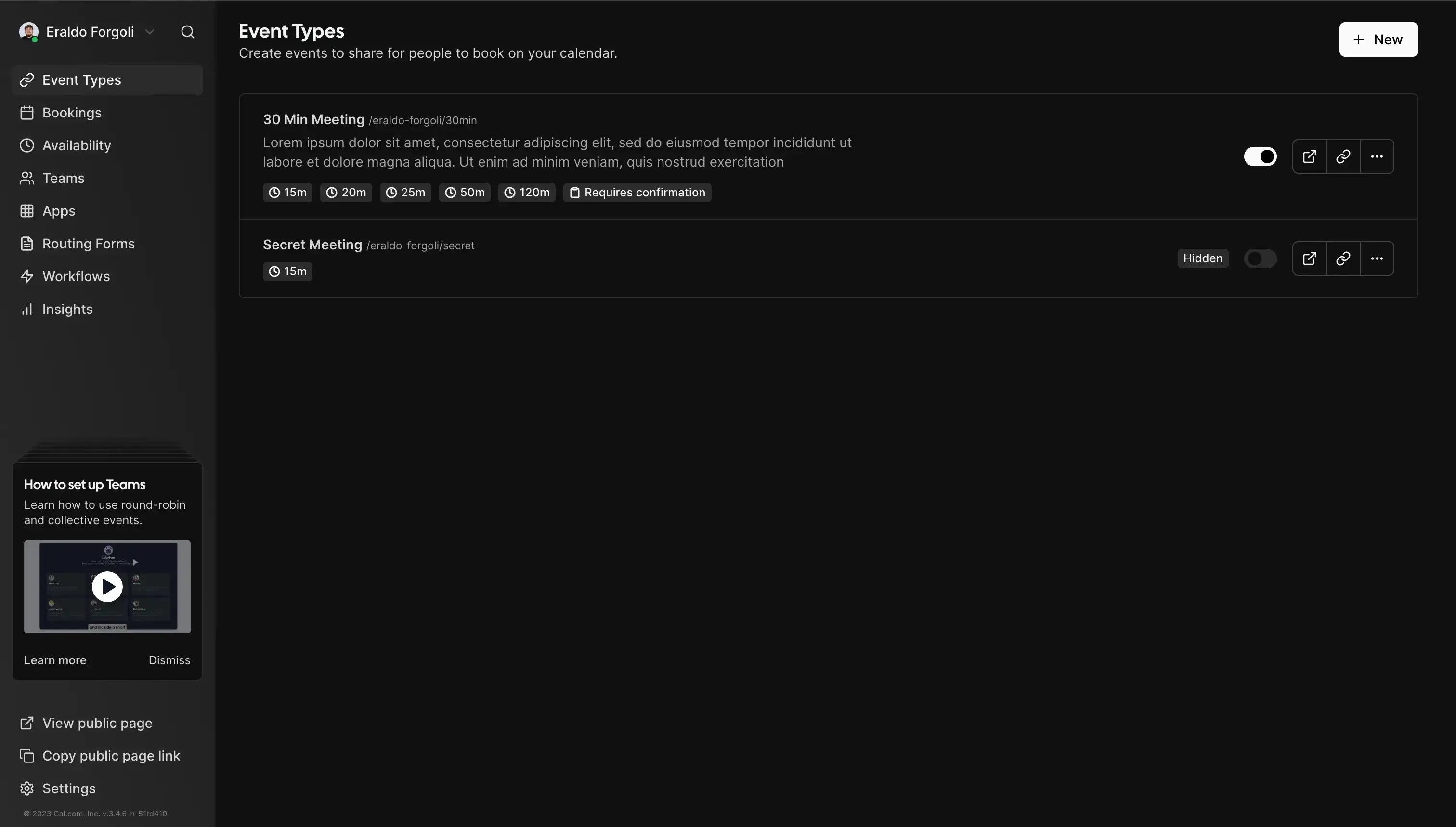
Calendly UI:
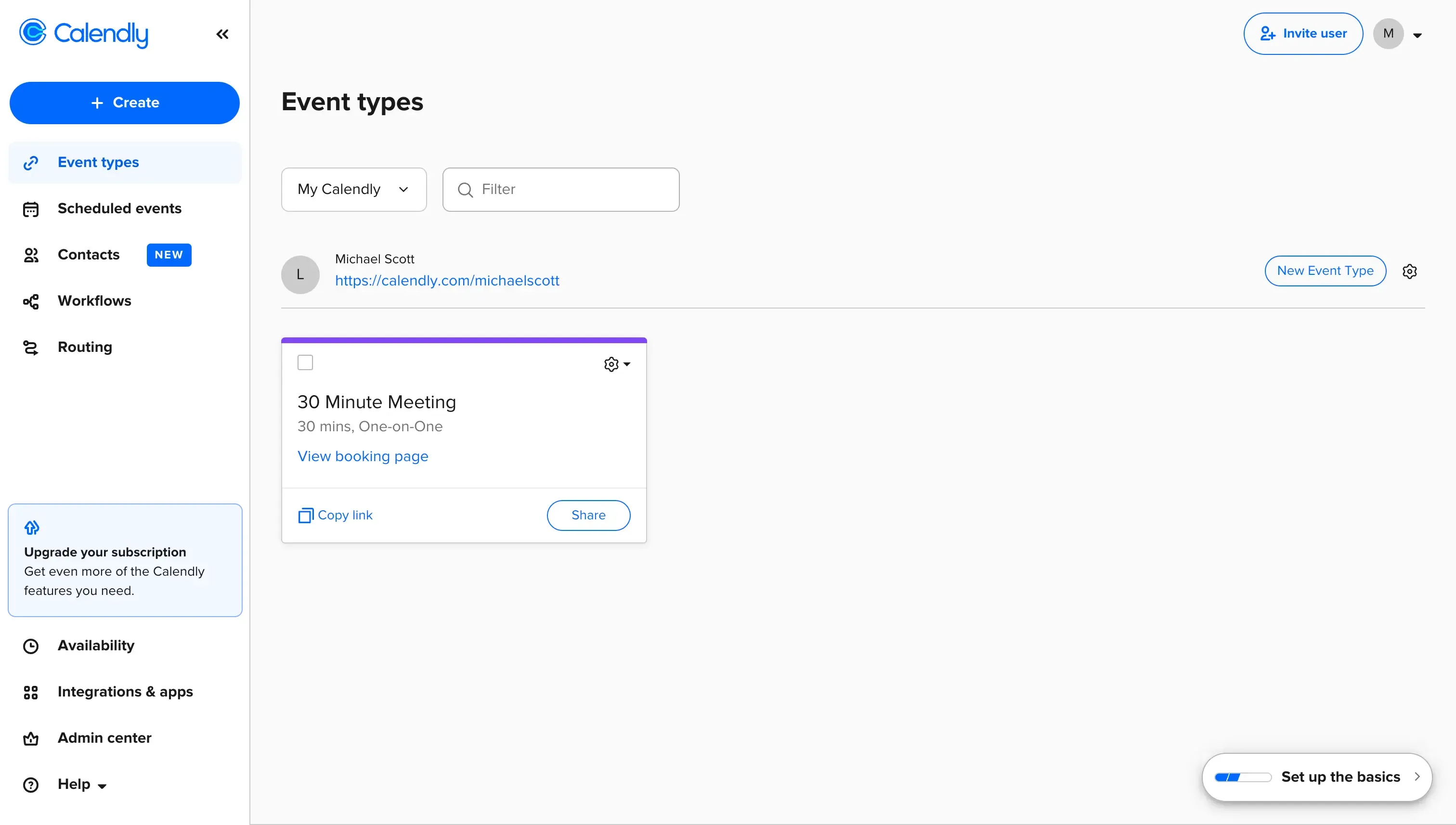
Conclusion: Even though Calendly just refreshed the look and feel, the UI & UX offered by Cal.com is still superior.
Customization
Generally speaking, Cal.com is more customizable than Calendly, due to its Open Source nature.
Cal.com:
Open-Source: As an open-source platform, Cal.com allows full access to its codebase. This means that developers can modify, tweak, and customize the software to an extensive degree, tailoring it to their specific needs.
Self-Hosting: Users can choose to self-host Cal.com, which offers the opportunity to customize the platform's infrastructure, and security settings, and to integrate it deeply with internal systems.
API Access: Developers have access to APIs that can be used to integrate Cal.com with other systems and to create custom features.
Calendly:
User Interface Customization: While Calendly offers a range of settings that users can customize (such as color schemes, booking flows, and automated notifications), these customizations are within a predefined framework.
Integrations: Calendly offers a variety of integrations with other tools and services. While these integrations offer a level of customization in terms of workflow, the core functionality of Calendly is not open to modification in the way that Cal.com is.
API for Developers: Calendly also offers an API for developers to create custom integrations and workflows. However, the customization is limited to the functionality exposed by the API and does not extend to the core application itself.
If you’re looking to customize a platform on an internal level, including core functionalities, appearance, integrations, and more, Cal.com would be more appropriate than Calendly. Calendly, while offering various customization options, is a proprietary tool and doesn’t provide the same level of access to its underlying code for such deep customization.
Conclusion: Cal.com is more customizable than Calendly due to its open-source nature, allowing more depth to customizing not only the appearance but also core functionalities.
Calendar View
It's a surprise that neither Cal.com nor Calendly offers a Calendar View feature that would allow you to view the events from all your calendars. This is what makes tools like OneCal unique, as you can create and share scheduling links, with the added ability to view all your calendars in one place, quickly join meetings, and more.
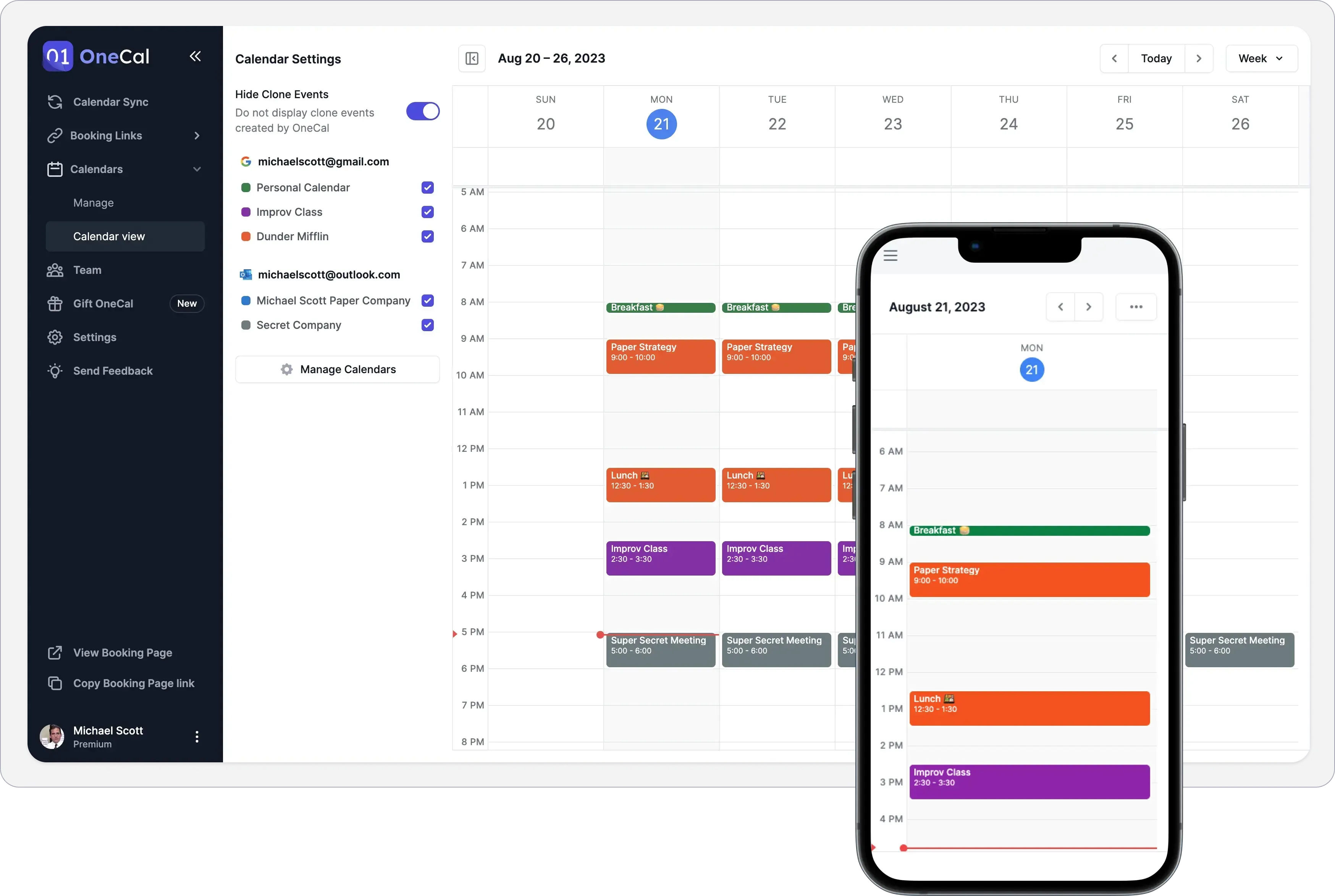
Platforms: Mobile, Web, Desktop?
Both Calendly and Cal.com are primarily designed for the web, but Calendly takes the edge as it has a mobile app that you can download on the Apple Store or Play Store.
Calendly: Mobile App, Web App
Cal.com: Web App
Neither Cal.com nor Calendly have a Desktop app, you’ll have to use the web version instead.
Conclusion: Calendly is the winner, as it has mobile apps available on the App Store and Play Store, compared to Cal.com which only has a web app.
Protection against scheduling conflicts
When building OneCal, our goal was to develop a platform that would put an end to scheduling conflicts. Platforms like Cal.com and Calendly only offer scheduling links, but what about hundreds of thousands of companies that schedule meetings internally using Google Calendar or Outlook, and operate using more than one calendar? What happens when you have a meeting in your work calendar, and a client schedules a meeting in another calendar? To answer this, we shipped the Calendar Sync feature, which allows you to sync Outlook and Google Calendars in real-time, automatically. After you sync your calendars, your availability is reflected in all your calendars, making sure everyone is on the same page, and scheduling conflicts are avoided.
Integrations
Both Calendly and Cal.com offer plenty of integrations, but Calendly takes the edge as it’s been in the market longer and has had more time and resources to integrate with third-party tools and services compared to Cal.com
Calendly Integrations:
Calendar services: Google Calendar, Outlook, Office 365, iCloud
Video conferencing tools: Zoom, Microsoft Teams, Google Meet, Webex
CRM systems: Salesforce, HubSpot
Payment processors: PayPal, Stripe
Productivity and team collaboration tools: Slack, Trello, and Zapier, which allow for connecting with numerous other services
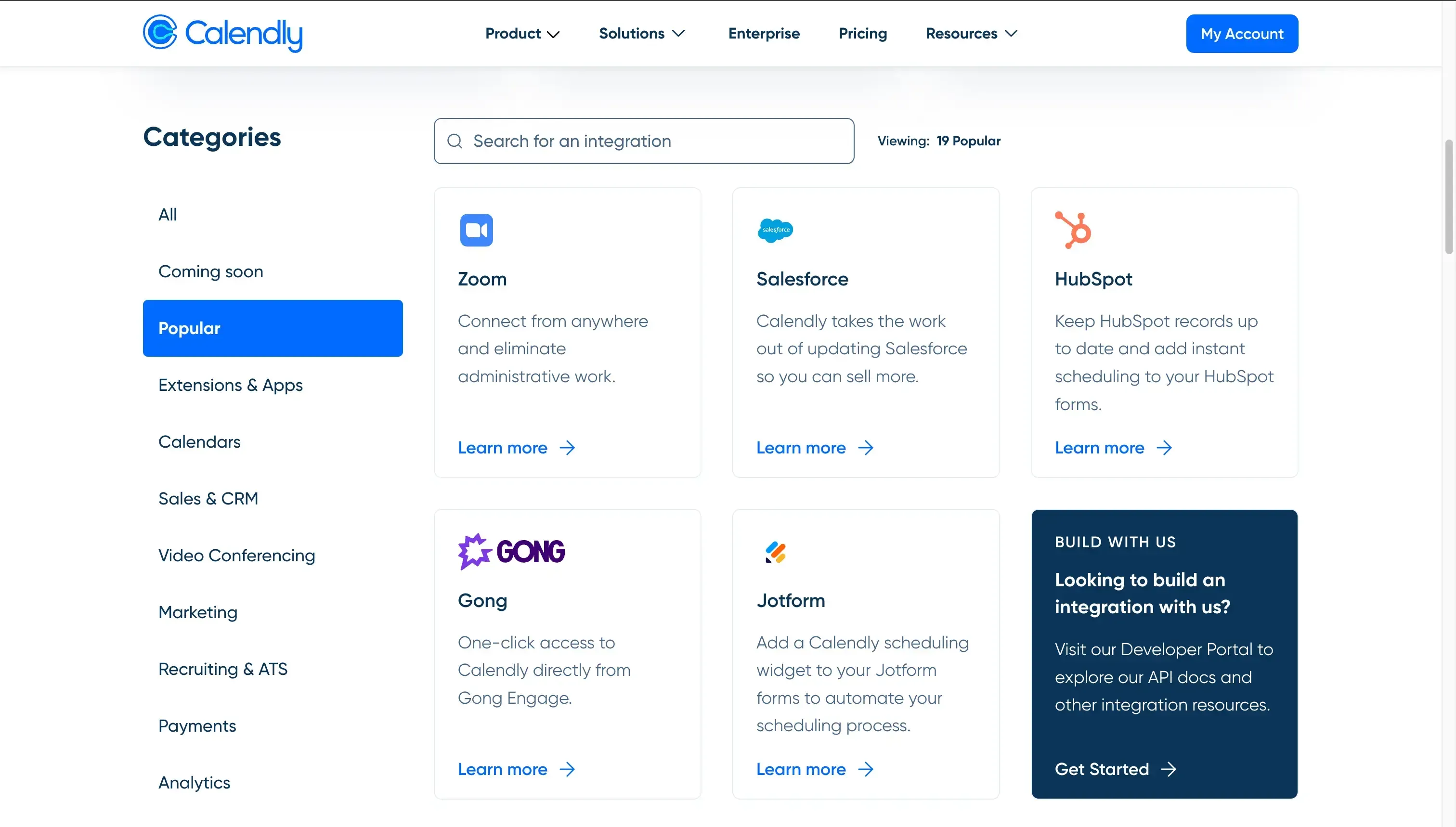
Cal.com, being newer and open-source, has a different approach. While it might not have as many pre-built integrations as Calendly, its open-source nature means it can potentially be integrated with any service if you have the development resources to do so. Cal.com’s integrations mainly include:
Calendar services (similar to Calendly)
Video conferencing tools (like Zoom and Microsoft Teams)
Some third-party apps, with the capacity to expand through their API and webhooks
Cal.com also has an interesting concept when it comes to integrations, called Apps. Integrations are available, and you have to install them through their App Store

For users who are not developers, Calendly’s wide range of ready-to-use integrations may be more appealing. For tech-savvy users or those with development resources who want a custom solution, Cal.com’s open API and the possibility to manipulate the code directly may offer a more flexible and potentially limitless integration landscape.
Conclusion: Cal.com and Calendly have plenty of integrations, but Calendly takes the edge it has slightly more integrations.
Collaboration
Calendly and Cal.com have collaboration at their core, as both platforms offer team scheduling and the ability to manage your team.
Calendly's Collaboration Features:
Team Scheduling: Calendly has robust features for team scheduling, allowing multiple team members to share a single scheduling link where clients can choose who they meet with based on availability or can round-robin to be assigned to the next available team member.
Centralized Billing: For teams and organizations, Calendly offers centralized billing, making it easier to manage subscriptions and payments.
Admin Features: Account administrators can manage team members’ access, set permissions, and control branding, ensuring consistency across client interactions.
Reporting and Metrics: Calendly provides analytics and reporting features that can help teams track their meeting volume, types of meetings, and other valuable metrics for business analysis.
Multiple Event Types: Team members can set up various types of events with different durations and availability, tailored to different meeting needs or services offered.
Cal.com's Collaboration Features:
Open-Source Customizability: Because Cal.com is open-source, teams with development resources can customize their scheduling system to fit their exact workflow and collaboration needs, potentially creating a more tailored experience.
Self-Hosting: Teams can choose to self-host Cal.com, which gives them full control over their data—a significant factor for collaboration in privacy-conscious industries.
Integration Flexibility: The ability to create custom integrations through APIs and webhooks means that Cal.com can potentially be integrated more deeply into existing team workflows and systems.
User Permissions: While Cal.com also allows user permissions and team scheduling, the extent and granularity of these features can depend on how much customization has been done to the platform.
Community Development: Being a community-driven project means that collaboration features in Cal.com can be extended or developed by contributions from its user base, which could be beneficial for teams needing specific functionality.
Overall, Calendly may be a better fit for teams looking for ready-made collaboration tools that are easy to use and don't require technical expertise to set up or manage. Cal.com takes the edge for teams that have the ability to develop custom solutions and who want to integrate deeply with their own systems, or for those who place a high priority on data control and privacy.
Another aspect to think of is the ability to self-host, which gives large enterprises the confidence to self-host, resting assured that they control their own data.
Conclusion: Calendly and Cal.com offer collaboration features in unique ways, so this is a tie.
Security
Security-wise, Calendly, and Cal.com adhere to industry standards, having ISO 27001, SOC 2 Type II, CCPA, GDPR, and more certifications.
Calendly security:
Customer Data Protection
Infrastructure Security
Application Protection
Compliance & Privacy
SOC 2 Type 2 Report
SOC 3 Report
GDPR & CCPA compliance management
CSA STAR Level One attestation
ISO/IEC 27001 report
FINRA guidelines for cybersecurity
GLBA guidelines for financial institutions
For more, please visit the Calendly Security Page.
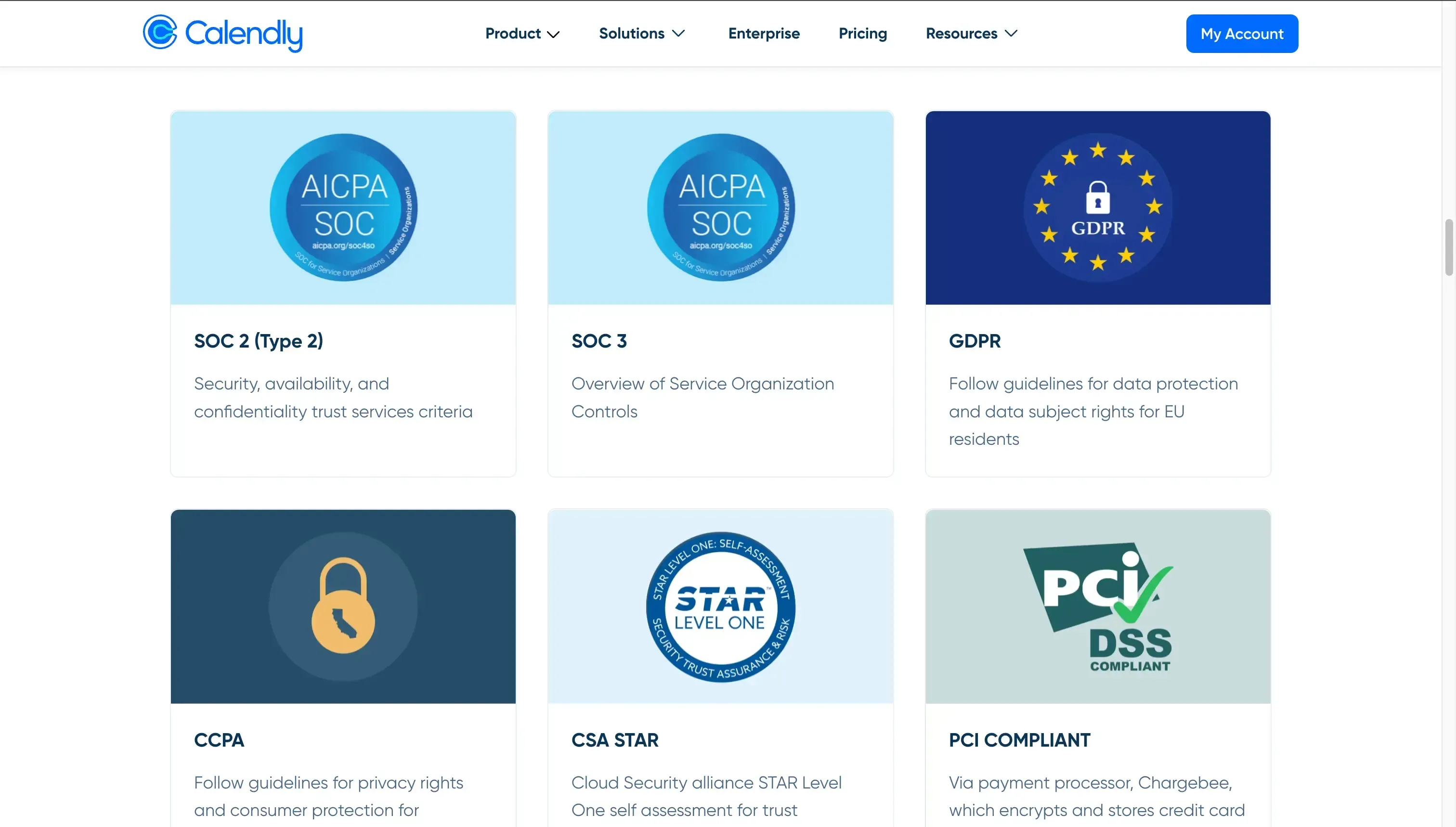
Account Protection
Cal.com Security:
ISO 27001
SOC 2 Type II
CCPA, GDPR
EU-US Data Privacy Framework
HIPAA certifications
For more, please visit the Cal.com Security Page.

Conclusion: It’s a tie, as both Cal.com and Calendly have all the security certificates and follow the highest standards when it comes to security.
Pricing
When it comes to pricing, Cal.com is more convenient, as it offers a free plan that allows you to create unlimited event types. Calendly on the other hand also has a free plan, but it limits you to only one event type. In order to create more scheduling links, you’ll have to upgrade to one of their free plans.
Even if you choose to upgrade, Cal.com is still cheaper, starting at $12 per user per month, compared to $16 per user per month in Calendly.
Calendly Pricing:
Free
Standard: $10 per seat, per month
Teams: $16 per seat, per month
Enterprise: Contact for pricing

Cal.com Pricing
Teams: $12/user/month.
Enterprise: You should contact them for pricing.
Platform: You should contact them for pricing.
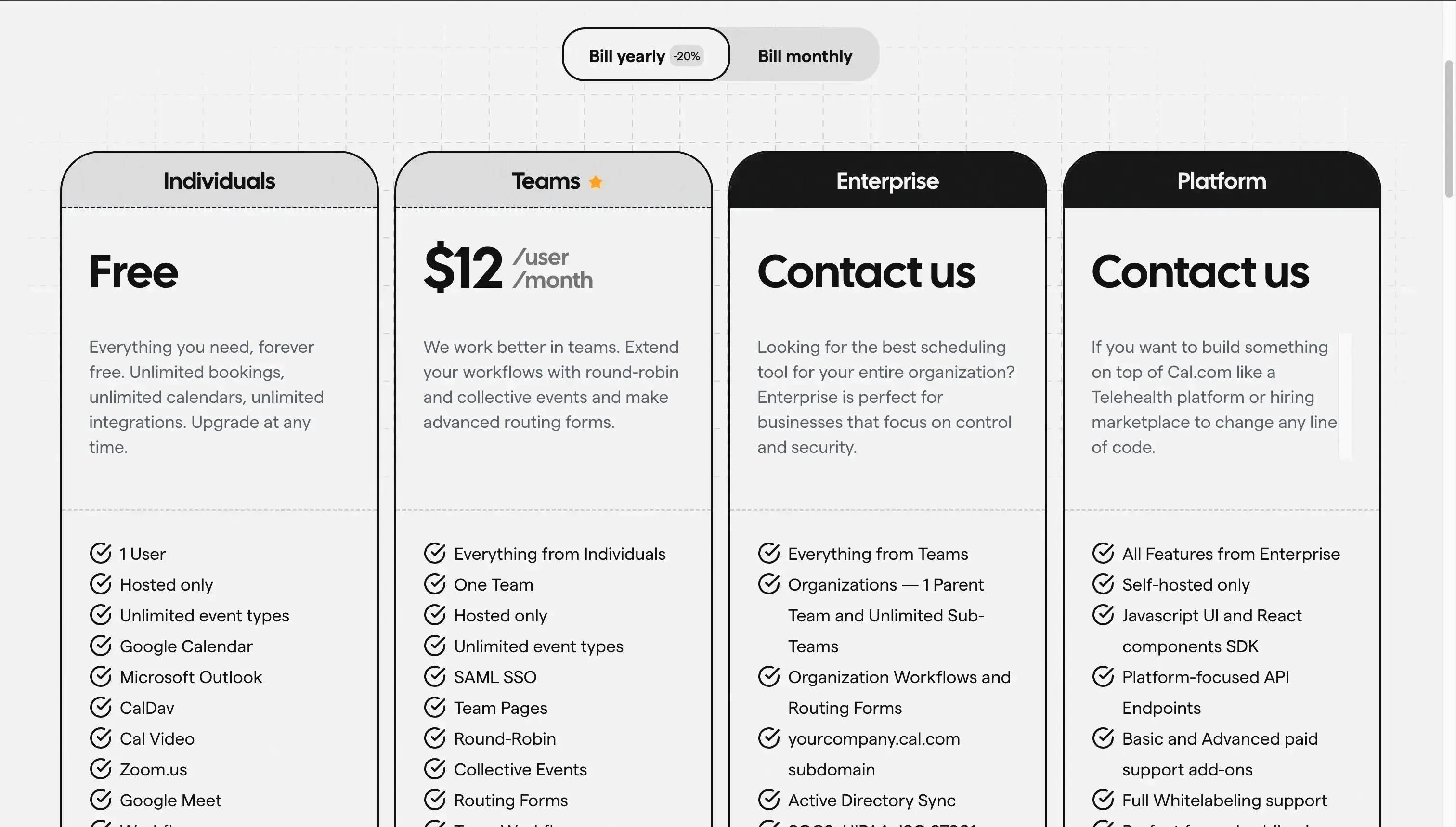
Conclusion: Cal.com takes the edge for pricing, as it’s more affordable while offering more features.
Calendly vs Cal.com: Comparison Overview
Let’s review each category we compared Cal.com vs Calendly:
|
Feature |
Winner |
|
Scheduling |
Tie |
|
UI and UX |
Cal.com |
|
Customization |
Cal.com |
|
Platforms: Mobile, Web, Desktop |
Calendly |
|
Integrations |
Calendly |
|
Collaboration |
Tie |
|
Security |
Tie |
|
Pricing |
Cal.com |
Calendly Vs Cal.com: Which Scheduling Tool is Better?
The major difference between Calendly and Cal.com is that Calendly has been a household name in the scheduling niche for over a decade, making it the go-to tool for individuals and businesses of any size, Cal.com, on the other hand, is a versatile scheduling platform that appeals more to enthusiasts who value transparency and open-source contribution
Furthermore, the open-source community seems to push the development velocity even more, releasing features such as Cal.ai, Calendar Overview, and more.
To add, even though both Calendly and Cal.com are excellent when it comes to booking links, they still lack a Calendar View feature, and the ability to sync Outlook and Google Calendars. This is where tools like OneCal shine, as it gives you the convenience of sharing intuitive scheduling links, with the ability to sync Outlook with Google Calendar in real-time.
Schedule your meetings using OneCal
Even though OneCal primarily focuses on syncing calendars, we also offer a booking links feature, that allows you to easily multi-purpose booking links.
You can Sign up for a 14-day free trial to get started, no credit card is required.